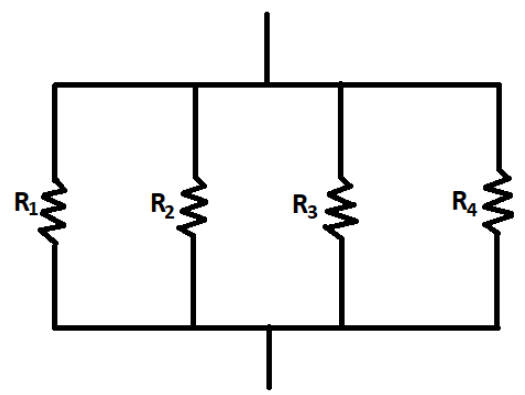
State the law of combination of resistances in parallel.
Answer
557.7k+ views
Hint: Resistors are said to be in a parallel state when both the terminals of the resistors are connected to each terminal of the other resistors. The resistors in parallel have a common voltage across all the resistors. Here, we will use four resistors connected in parallel to find the law of combination of resistances.
Complete answer:
The figure below shows the circuit in which the resistors are placed parallel to each other.

Let ${R_1}$ , ${R_2}$ , ${R_3}$ and ${R_4}$ are resistors that are connected parallel to each other. Here, the voltage drop across each resistor will be the same but the electric current in the circuit will divide itself to travel through all the different branches. Now. to derive the equation of resistance in parallel, we will use Ohm’s law which is given by
$V = IR$
$I = \dfrac{V}{R}$
Here, $I$ is the current in the circuit, $V$ is the voltage, and $R$ is the resistance in the circuit.
Now, according to Kirchhoff’s law, we get
$\sum {{I_{in}}\, = \,\sum {{I_{out}}} } $
$ \Rightarrow \,I = {I_1} + {I_2}$
$I = \dfrac{{{V_1}}}{{{R_1}}} + \dfrac{{{V_2}}}{{{R_2}}}$
Since the voltage drop across the resistors is the same. Therefore,
$I = \dfrac{V}{{{R_1}}} + \dfrac{V}{{{R_2}}}$
$ \Rightarrow \,I = V\left( {\dfrac{1}{{{R_1}}} - \dfrac{1}{{{R_2}}}} \right)$
$ \Rightarrow \,\dfrac{I}{V} = \left( {\dfrac{1}{{{R_1}}} - \dfrac{1}{{{R_2}}}} \right)$
$ \Rightarrow \,{R_p} = {\left( {\dfrac{1}{{{R_1}}} - \dfrac{1}{{{R_2}}}} \right)^{ - 1}}$
Therefore, the resistance in the parallel series are
$\therefore{R_p} = {\left( {\dfrac{1}{{{R_1}}} + \dfrac{1}{{{R_2}}} + ...... + \dfrac{1}{{{R_{n - 1}}}} + \dfrac{1}{{{R_n}}}} \right)^{ - 1}}$
This means that the combined resistance in the parallel circuit will be equal to the sum of the reciprocal of all the individual resistances.Therefore, the law of combination of resistances in parallel states that the reciprocal of the combined resistance of all the resistors connected in parallel is equal to the sum of the reciprocal of all the individual resistance.
Note:In a parallel resistor circuit, the voltage across all the resistors will be the same. Therefore, the voltage in the resistor ${R_1}$ will be equal to the voltage in the resistor ${R_2}$ and is also equal to the voltage in the resistor ${R_3}$ . That is why we have used the same voltage for all the resistances.
Complete answer:
The figure below shows the circuit in which the resistors are placed parallel to each other.

Let ${R_1}$ , ${R_2}$ , ${R_3}$ and ${R_4}$ are resistors that are connected parallel to each other. Here, the voltage drop across each resistor will be the same but the electric current in the circuit will divide itself to travel through all the different branches. Now. to derive the equation of resistance in parallel, we will use Ohm’s law which is given by
$V = IR$
$I = \dfrac{V}{R}$
Here, $I$ is the current in the circuit, $V$ is the voltage, and $R$ is the resistance in the circuit.
Now, according to Kirchhoff’s law, we get
$\sum {{I_{in}}\, = \,\sum {{I_{out}}} } $
$ \Rightarrow \,I = {I_1} + {I_2}$
$I = \dfrac{{{V_1}}}{{{R_1}}} + \dfrac{{{V_2}}}{{{R_2}}}$
Since the voltage drop across the resistors is the same. Therefore,
$I = \dfrac{V}{{{R_1}}} + \dfrac{V}{{{R_2}}}$
$ \Rightarrow \,I = V\left( {\dfrac{1}{{{R_1}}} - \dfrac{1}{{{R_2}}}} \right)$
$ \Rightarrow \,\dfrac{I}{V} = \left( {\dfrac{1}{{{R_1}}} - \dfrac{1}{{{R_2}}}} \right)$
$ \Rightarrow \,{R_p} = {\left( {\dfrac{1}{{{R_1}}} - \dfrac{1}{{{R_2}}}} \right)^{ - 1}}$
Therefore, the resistance in the parallel series are
$\therefore{R_p} = {\left( {\dfrac{1}{{{R_1}}} + \dfrac{1}{{{R_2}}} + ...... + \dfrac{1}{{{R_{n - 1}}}} + \dfrac{1}{{{R_n}}}} \right)^{ - 1}}$
This means that the combined resistance in the parallel circuit will be equal to the sum of the reciprocal of all the individual resistances.Therefore, the law of combination of resistances in parallel states that the reciprocal of the combined resistance of all the resistors connected in parallel is equal to the sum of the reciprocal of all the individual resistance.
Note:In a parallel resistor circuit, the voltage across all the resistors will be the same. Therefore, the voltage in the resistor ${R_1}$ will be equal to the voltage in the resistor ${R_2}$ and is also equal to the voltage in the resistor ${R_3}$ . That is why we have used the same voltage for all the resistances.
Recently Updated Pages
Two men on either side of the cliff 90m height observe class 10 maths CBSE

What happens to glucose which enters nephron along class 10 biology CBSE

Cutting of the Chinese melon means A The business and class 10 social science CBSE

Write a dialogue with at least ten utterances between class 10 english CBSE

Show an aquatic food chain using the following organisms class 10 biology CBSE

A circle is inscribed in an equilateral triangle and class 10 maths CBSE

Trending doubts
The shortest day of the year in India

Why is there a time difference of about 5 hours between class 10 social science CBSE

Write a letter to the principal requesting him to grant class 10 english CBSE

What is the median of the first 10 natural numbers class 10 maths CBSE

The Equation xxx + 2 is Satisfied when x is Equal to Class 10 Maths

What is the missing number in the sequence 259142027 class 10 maths CBSE




